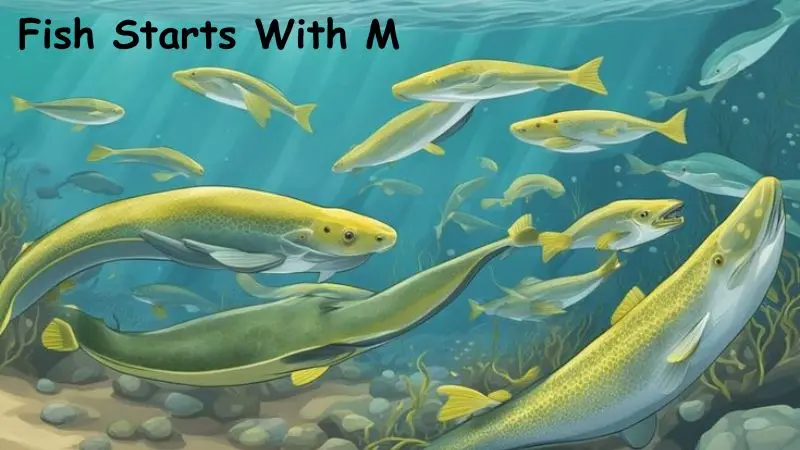fish diversity
Fish Starts With M
The vast and enigmatic underwater world teems with life, a tapestry of vibrant colors, intricate shapes, and fascinating adaptations. Among this diverse array of creatures, fish stand out as a particularly captivating group, their sleek bodies and graceful movements captivating our imaginations.
While the vast majority of fish species bear names that begin with letters other than “M,” a select few hold the distinction of starting their names with this particular letter. These “M” fish, though less numerous, are no less intriguing, each possessing unique characteristics and playing vital roles within their respective ecosystems.
This essay of fishtankmagic.com delves into the fascinating world of “M” fish, exploring their diverse forms, intriguing behaviors, and the ecological significance they hold. From the mighty marlin to the elusive moray eel, we will embark on a journey to uncover the secrets of these captivating creatures, shedding light on their adaptations, habitats, and the delicate balance they maintain within the intricate web of life.
Fish Starts With M
The Majestic Marlin: A Master of Speed and Strength
The marlin, a name synonymous with power and grace, embodies the very essence of a “M” fish. These magnificent creatures, belonging to the family Istiophoridae, are renowned for their streamlined bodies, elongated bills, and remarkable speed. The bill, a prominent feature of the marlin, serves as a weapon for hunting, allowing them to spear their prey with deadly accuracy.
Marlins are found in tropical and subtropical waters around the globe, inhabiting both the open ocean and coastal regions. Their impressive size, reaching lengths of over 14 feet and weights exceeding 1,800 pounds, makes them a formidable force in the marine environment. The blue marlin, in particular, is a true giant, often exceeding 1,000 pounds in weight.
The marlin’s ability to reach astonishing speeds, exceeding 50 miles per hour, is a testament to its streamlined body and powerful musculature. This remarkable speed allows them to chase down fast-moving prey, such as squid, tuna, and other fish. Their agility and hunting prowess have made them a prized target for sport fishermen, though their populations are facing increasing pressure due to overfishing and habitat degradation.
The Elusive Moray Eel: A Master of Ambush
In stark contrast to the majestic marlin, the moray eel embodies a different kind of “M” fish, one that thrives in the shadows and relies on stealth and cunning. These serpentine creatures, belonging to the family Muraenidae, are characterized by their elongated bodies, lack of pectoral and pelvic fins, and powerful jaws lined with sharp teeth.
Moray eels are found in tropical and subtropical waters, inhabiting coral reefs, rocky shores, and seagrass beds. They are primarily nocturnal hunters, spending their days hidden within crevices and caves, emerging at night to ambush their prey. Their ambush strategy relies on their powerful jaws and sharp teeth, allowing them to seize their prey with lightning speed.
Moray eels are known for their fierce reputation, and their bite can be quite painful. However, they are generally shy creatures, preferring to avoid confrontation. They play a crucial role in maintaining the health of coral reefs, keeping populations of smaller fish in check and contributing to the overall biodiversity of the ecosystem.
The Versatile Mackerel: A Schooling Mastermind
Mackerel, a common sight in coastal waters around the world, represents another fascinating “M” fish. These sleek, streamlined creatures, belonging to the family Scombridae, are known for their schooling behavior, their ability to swim in large, coordinated groups.
Mackerels are found in both temperate and tropical waters, inhabiting coastal regions, open oceans, and even freshwater environments. Their bodies are perfectly adapted for speed and agility, allowing them to dart through the water with ease. Their schooling behavior provides them with protection from predators, as they can confuse attackers with their coordinated movements.
Mackerel are an important food source for humans and other marine animals, playing a vital role in the marine food web. They are also highly prized for their delicious taste and nutritional value. However, overfishing and habitat degradation pose significant threats to mackerel populations, highlighting the need for sustainable fishing practices.
The Mighty Mudskipper: A Master of Amphibious Living
The mudskipper, a unique and intriguing creature, represents a different kind of “M” fish, one that has mastered the art of amphibious living. These remarkable fish, belonging to the family Gobiidae, are found in mudflats and mangrove swamps along the coasts of Africa, Asia, and Australia.
Mudskippers are adapted to life both in and out of water, possessing a number of unique features that allow them to survive in this harsh environment. Their eyes are positioned on top of their heads, giving them a wide field of vision both in and out of water. They also possess specialized pectoral fins that allow them to “walk” across land.
Mudskippers are primarily carnivorous, feeding on insects, worms, and crustaceans. They are also known for their ability to breathe air, allowing them to survive out of water for extended periods. Their unique adaptations and amphibious lifestyle make them a fascinating example of the diversity and resilience of life in the marine environment.
The Colorful Mantis Shrimp: A Master of Striking Power
The mantis shrimp, a seemingly unassuming creature, possesses a hidden power that belies its small size. These fascinating crustaceans, belonging to the order Stomatopoda, are known for their lightning-fast strikes, which can generate forces exceeding 1,500 pounds per square inch.
Mantis shrimps are found in tropical and subtropical waters, inhabiting coral reefs and rocky shores. They are highly predatory, using their powerful claws to crush their prey, which includes crabs, snails, and even other mantis shrimps. Their strikes are so powerful that they can shatter aquarium glass, highlighting the incredible force they can generate.
Mantis shrimps are also known for their complex eyes, which can perceive a wider range of colors than humans. Their remarkable visual capabilities allow them to detect subtle changes in their environment, helping them to locate prey and avoid predators.
The Curious Mantas: Gentle Giants of the Deep
The manta ray, a graceful and majestic creature, embodies the gentle side of “M” fish. These magnificent rays, belonging to the family Mobulidae, are characterized by their large, wing-like pectoral fins, which they use to glide through the water with effortless grace.
Mantas are found in tropical and subtropical waters around the globe, inhabiting both coastal and oceanic regions. They are filter feeders, using their large mouths to strain plankton from the water. Their gentle nature and impressive size have earned them the nickname “gentle giants.”
Mantas are highly intelligent creatures, capable of complex social interactions and learning new behaviors. They are also known for their acrobatic displays, often leaping out of the water and performing aerial somersaults. Their unique adaptations and gentle nature make them a captivating example of the diversity and wonder of the marine world.
Conclusion: A Celebration of Diversity and Resilience
The “M” fish, though a small group compared to the vast array of fish species, represent a remarkable testament to the diversity and resilience of life in the marine environment. From the majestic marlin to the elusive moray eel, each “M” fish possesses unique characteristics and plays a vital role in maintaining the health and balance of marine ecosystems.
However, these creatures are facing a number of threats, including overfishing, habitat degradation, and climate change. It is our responsibility to protect these fascinating creatures and the ecosystems they inhabit, ensuring that future generations can continue to marvel at their beauty and appreciate their vital role in the intricate web of life.
By implementing effective conservation measures, we can help to safeguard the future of “M” fish and the marine ecosystems they call home, ensuring that the underwater world continues to teem with life and wonder for generations to come.












